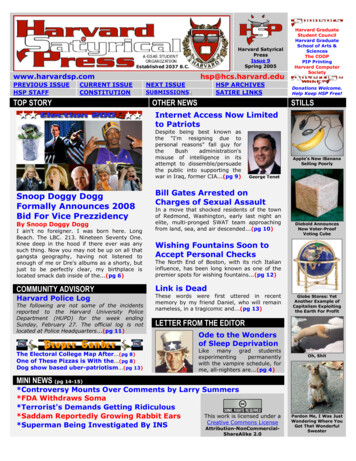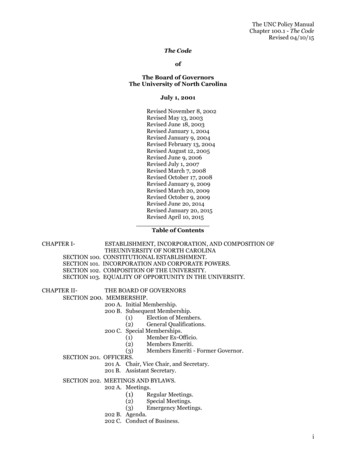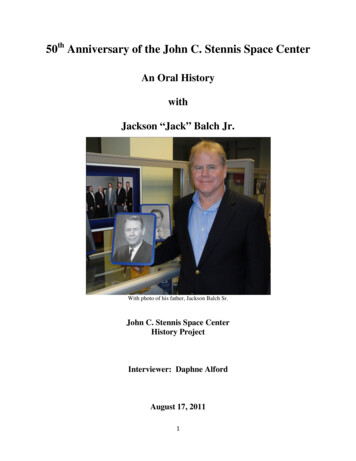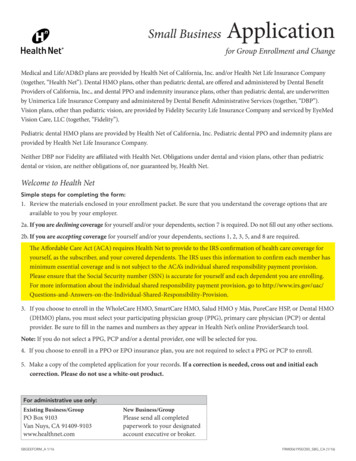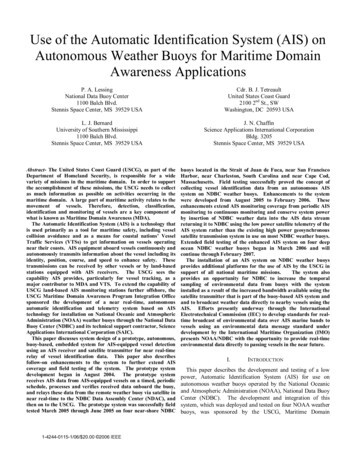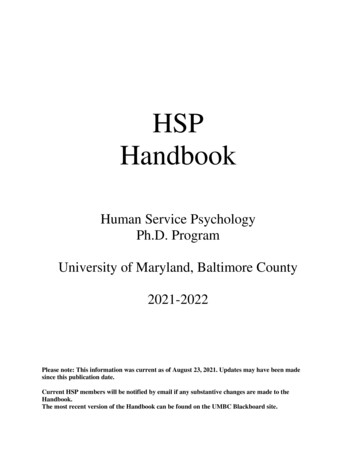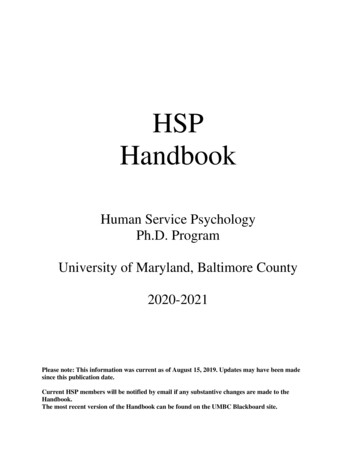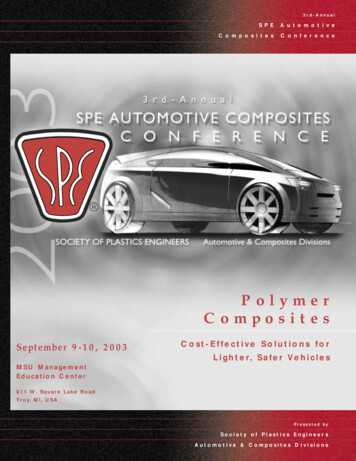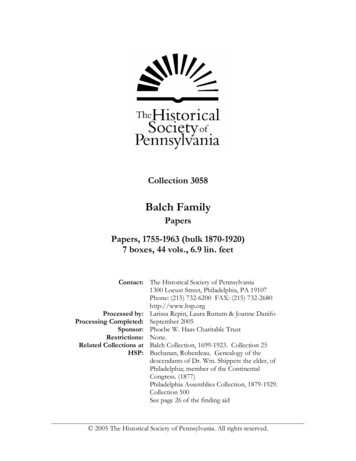
Transcription
Collection 3058Balch FamilyPapersPapers, 1755-1963 (bulk 1870-1920)7 boxes, 44 vols., 6.9 lin. feetContact: The Historical Society of Pennsylvania1300 Locust Street, Philadelphia, PA 19107Phone: (215) 732-6200 FAX: (215) 732-2680http://www.hsp.orgProcessed by: Larissa Repin, Laura Ruttum & Joanne DanifoProcessing Completed: September 2005Sponsor: Phoebe W. Haas Charitable TrustRestrictions: None.Related Collections at Balch Collection, 1699-1923. Collection 25HSP: Buchanan, Roberdeau. Genealogy of thedescendants of Dr. Wm. Shippen: the elder, ofPhiladelphia; member of the ContinentalCongress. (1877)Philadelphia Assemblies Collection, 1879-1929.Collection 500See page 26 of the finding aid 2005 The Historical Society of Pennsylvania. All rights reserved.
Balch Family papersCollection 3058Balch FamilyPapers, 1755-1963 (bulk 1870-1920)7 boxes, 44 vols., 6.9 lin. feetCollection 3058AbstractThomas Balch (1821-1877) was born in Leesburg, Virginia to Lewis Penn WitherspoonBalch and Elizabeth Willis Weaver. He attended Columbia University and moved toPhiladelphia, where he was admitted to the bar in 1850. In 1852, he married Emily Swift(1835-1917) and together they had three children: Elise Willing Balch (1853-1913),Edwin Swift Balch (1856-1927), and Thomas Willing Balch (1866-1927). The Balchfamily resided in Europe from 1859 to 1873 during which time Thomas (d. 1877)conducted research for several of the books and articles he wrote. His two most notableworks are Les Francais en Amérique Pendant le Guerre de l’Indépendence, which exploresFrance’s role in the American Revolution, and International Courts of Arbitration, which waswritten in aftermath of the sinking of the Alabama during the Civil War. Thomas Balchpassed away in 1887 in Philadelphia. His sons Edwin Swift (d. 1927) and ThomasWilling (d. 1927) both graduated from Harvard University with law degrees. Much liketheir father, they pursued writing careers instead of careers in law. Edwin immersedhimself in geographic exploration and wrote several articles and books about theAntarctic region. Edwin married Eugenia Macfarlane and upon her death in 1921, hemarried Emily Clark. Thomas (d. 1927) combined the interests of his father and brotherand wrote several works about the Alaskan border and Candian-American relations. Healso translated his father’s Les Francais en Amérique and issued another version ofInternational Courts of Arbitration after his father’s death. Thomas (d. 1927) also wrotebooks relating to Philadelphia history and the history of his ancestors, including ThePhiladelphia Assemblies, Willing Letters and Papers, and The Swift Family of Philadelphia.Thomas Willing Balch married Dulany Whiting in 1923. Elise Willing Balch, the oldersister of Edwin and Thomas, never married and passed away in 1913. Emily Swift Balchdied in 1917 and her sons died ten years later only months apart in 1927. Elise, Edwin,and Thomas did not have children.The Balch Family Papers span from 1755 to 1963 and are comprised of seven boxes andforty-three volumes. The collection has been divided into six series – Thomas Balch andEmily Swift Balch (1780-1914); Edwin Swift Balch and Eugenia MacFarlane Balch (1859-1924);Elise Willing Balch (1881-1914); Thomas Willing Balch and Dulany Whiting Balch (1867-1929);Early Balches and related families (1755-1963); and Miscellaneous photographs, volumes, and1Historical Society of Pennsylvania
Balch Family papersCollection 3058artifacts (1755-1909). The materials in the collection offer insight into the personal livesof the Balch family members and showcase their interests and skills. The majority of thecollection is the incoming and outgoing correspondence of Thomas (d. 1877), EdwinSwift (d. 1927), Thomas Willing (d. 1927), and their wives and the published works ofThomas and his two sons.Background noteThe earliest recorded Balches in America date to the seventeenth century when threeBalches arrived in America are three different time periods. John Balch came to Americain 1623 and settled in Massachusetts; another Balch family member established himselfin the colony of Virginia; and the third Balch, also named John, left Somerset, Englandfor Maryland in 1658.The Philadelphia branch of the Balch family traces its roots to Stephen Bloomer Balch(1747-1833). Stephen was born in Deer Creek, Maryland on April 5, 1747 and was thebrother of Hezekiah James Balch, who became a noted clergymen and signer of theMecklenberg Declaration of Independence. Stephen attended school at the College ofNew Jersey, later named Princeton University, where he graduated in the class of 1774with a bachelor of the arts degree. After graduation, he became the principal of theLower Marlborough Academy in Calvert County, Maryland. With the AmericanRevolution looming on the horizon, Stephen was offered a commission as the captain ofthe Calvert County militia, a command in which he would remain until 1777.After serving in the war, Stephen left Maryland for North Carolina, where he became anitinerant preacher. He was licensed as itinerant preacher in the Presbytery of Donegal inJune 1779. One year later he established the Bridge Street Presbyterian Church ofGeorgetown, in the present-day District of Columbia, and he served as pastor for thenext fifty-three years. He also became involved in education and he established and rana classical academy in Georgetown in 1798 and five years later he founded and became amember of the board of trustees of the Columbian Library.Stephen Bloomer Balch married Elizabeth Beall (1762-1827) on June 10, 1781.Together, Stephen and Elizabeth had eleven children: Anne Ann (b. 1782), Harriet (b.1783), Alfred (b. 1785), Lewis Penn Witherspoon (b. 1787), George Beall (b. 1789),Hezekiah James (b. 1791), Thomas Bloomer (b. 1793), Franklin (b. 1795), AnnaEleanora (b. 1799), Elizabeth Maria (b. 1802), and Jane Whann (b. 1805). ElizabethBeall died June 27, 1821. Seven years later, Stephen married Elizabeth King, but thismarriage lasted less than a month and Elizabeth died suddenly November 23, 1828.Two years later, Stephen married his third and last wife, Jane Parrott. Stephen’s secondand third marriages did not produce him any more children and he passed away in 1833.Many of his children went on to become notable figures in American politics andhistory. Alfred Balch graduated Princeton in 1805, became the head of the BarAssociation in Nashville, was appointed a United States District judge by Martin vanBuren, and commissioner of Indian Treaties by Andrew Jackson. His brother ReverendDoctor Thomas Bloomer Balch (1793-1878) also graduated Princeton in 1813, became anoted Presbyterian minister, and religious writer. Lewis Penn Witherspoon Balch (17872Historical Society of Pennsylvania
Balch Family papersCollection 30581868), whose children would continue the Balch tradition of scholarship, graduatedPrinceton in 1806 and practiced law in Loudon County, Virginia, later becoming a judge.Lewis Penn Witherspoon Balch married Elizabeth Willis Weaver (1790-1874) in 1811and together they had twelve children: Adam Weber (b. 1812), Catharine Spencer (b.1815), Virginia (b. 1818), Harriet (b. 1819), Thomas (b. 1821) Anne Ball (b. 1823),Sylvester Whitefield (b. 1825), John Wilson (b. 1826), Frances Carter (b. 1827),Alexandrine (b. 1828), Stephen Fitzhugh (b. 1831), and Lewis Penn Witherspoon (b.1844). The family resided in Leesburg, Virginia until Thomas Balch (1821-1877) wasfive years old and they relocated to Frederick, Maryland. Thomas (d. 1877) received hisearly education in Frederick and subsequently attended Columbia University in NewYork starting in 1838. After several years of studying law, he was admitted to the NewYork Bar on January 17, 1845. Soon, Thomas Balch left New York, with law degree intow, and moved to Philadelphia, where he was admitted to the local bar association onFebruary 9, 1850. On October 5, 1852, Thomas Balch (d. 1877) married Emily Swift(1835-1917), the daughter of Joseph Swift and Eliza Moore Willing.Emily Swift’s parents were members of two of the leading families in Philadelphia at thetime. On her mother’s side, Emily was a descendant of Thomas Willing (1731-1821),who was a justice of the Pennsylvania Supreme Court, mayor of Philadelphia in 1763,and one of the founders of the Bank of the United States. Thomas was also the greatgrandson of Edward Shippen, the first mayor of Philadelphia. The Swift family camefrom England in the eighteenth century and soon became fixtures in the Philadelphiapolitical and social scene. John Swift (b. 1720), Emily’s father’s great-uncle, was amember of the city council and, along with Lynford Lardner was responsible forinstituting the Philadelphia Dancing Assemblies, which began in the 1740s and wouldcontinue for more than 150 years. John’s brother Joseph Swift (1731-1806) forged abusiness partnership and they became successful merchants. Joseph was also one of thesigners of the Non-Importation Resolutions of 1765, held several political offices, andwas a trustee of the Academy of the Protestant Episcopal Church. Joseph Swift (17311806) married Margaret McCall and in 1771 Margaret gave birth to Samuel Swift, whowas involved in Trinity Espiscopal Church. In 1795, Samuel (1771-1842) married MaryShippen, the daughter of Joseph Shippen the secretary to the Provinicial Council ofPennsylvania. Together, Samuel (d. 1842) and Mary had eleven children, including EmilySwift’s father Joseph Swift (1799-1882). Joseph (d. 1882) participated in local politics,was one of the original members of the Philadelphia Club, and married Eliza MooreWilling in 1831.The years following his marriage to Emily were eventful ones for Thomas Balch (d.1877). In 1853, Thomas was elected one of the domestic secretaries of the HistoricalSociety of Pennsylvania and the next year, he was elected to a two-year position on thecommon council of Philadelphia, helped to establish the Philadelphia Cricket Club, andthe Seventy-Six Society, which published historical manuscripts and rare books. Andalthough he was admitted as a counselor to the bar of the United States Court in 1855,he practiced law less and less. Instead, he began to edit and write different articles andbooks, usually of a legal and historical nature. Between 1855 and 1857, he edited andwrote The Examination of Joseph Galloway, Esq. by a Committee of the House of Commons, Letters3Historical Society of Pennsylvania
Balch Family papersCollection 3058and Papers Relating Chiefly to Provincial History of Pennsylvania (more commonly known as theShippen Papers), and Papers Relating Chiefly to the Maryland Line During the Revolution.Thomas (d. 1877) and Emily (d. 1917) left the United States in 1859, shortly after thebirths of their first two children, Eliza Willing (who would at some point change hername to Elise) and Edwin Swift and would live in Europe for the next fourteen years.The Balch’s permanent residence was in Paris, France, but Thomas (d. 1877) traveledextensively due to the research that he was conducting. He was now devoting all of histime to his research as he traveled to various libraries and corresponded with historicalsocieties and other related institutions. His area of interest was France’s involvement inthe American Revolution and its role in the establishment of the United States ofAmerica. However, while he was conducting this research an event took place thatwould change the course of his writings and would make him well-known in theinternational community.Across the Atlantic Ocean, the Civil War was raging with the Northern states pittedagainst the Southern states. Battles were being fought on land and at sea and both sideshad seen siginificant losses by 1862. It was in this atmosphere that the Confederateforces launched the Alabama on July 29, 1862. The Alabama was one of many battleships constructed by England for the Confederate forces, but they were often disguisedas merchant vessels in order to circumvent England’s neutrality laws. Disguised as acommercial ship, the Alabama successfully captured fifty-eight Union vessels before itwas sunk in 1864 off the coast of France. Thomas Balch was in Cherbourg, Francewhen the Alabama met its fate at the hands of Kearsarge, a Union warship. Balchunderstood the gravity of this event and worried about its affects on internationalrelations, especially those between the United States and Britain. His fears were notunfounded, because the United States government filed claims against the Britishgovernment at the end of the Civil War. In the Alabama Claims, chairman of the SenateForeign Relations Committee Charles Sumner argued that England’s support of theConfederate cause had violated their neutrality lies, prolonged the war an additional twoyears, and cost the United States federal government billions of dollars. The stage wasnow set for Thomas Balch to bring forth the theory of international arbitration.The theory of international arbitration was believed to be originated by Émeric Crucéand was a process that hoped to resolve conflicts that occurred between two nations,such as the one that was now straining American-British relations. Thomas Balch, whohad researched this idea, returned briefly to the United States to suggest internationalabritration to President Abraham Lincoln as a way of ending this disagreement in apeaceful manner. Lincoln was not exactly receptive to the idea and Balch returned toFrance, but still believed that international abritration was path toward a peacefulresolution. He eventually returned to the the United States in 1868, tried to rally CharlesSumner and President Grant behind international arbitration, and soon the idea grew inpopularity. Eventually an international tribunal comprised of the United Kingdom, theUnited States, Brazil, and Switzerland met in Washington D.C. to discuss the grievancesof the United States. The result was the Treaty of Washington, in which Great Britainawarded America 15.5 million and issued a formal apology.4Historical Society of Pennsylvania
Balch Family papersCollection 3058With this episode behind him, Thomas Balch refocused his efforts on his research. Alsoin the midst of the affairs of the Alabama Claims, Emily gave birth to the couple’s lastchild, Thomas Willing Balch, in 1866. Several years later, he published Les Francais enAmérique, which was a culmination of the background research he was conducting inEurope. The Balch family returned to Philadelphia a year after the book was publishedin 1873. Thomas Balch (d. 1877) resumed his involvement in Philadelphia society.Among many activities, he organized the Social Art Club, now called the RittenhouseClub, in 1875, was elected an honorary member of the American Whig Society ofPrinceton University, and was accepted as a corresponding member of the VirginiaHistorical Society in 1877. Thomas Balch died at his home in Philadelphia at 1412Spruce Street on March 29, 1877. In 1922, his sons Edwin and Thomas donated 10,000 to build a public library in their father’s birthplace, Leesburg, Virginia.The eldest son of Thomas Balch and Emily Swift Balch, Edwin Swift Balch (1856-1927),was born March 27, 1856 in Philadelphia, Pennsylvania. When his family moved toEurope in 1859, Edwin attended Kundermann’s school in Wiesbaden, Germany. Upontheir return to the United States in 1873, Edwin enrolled in Fay’s School located inNewport, Rhode Island for year and then returned to Philadelphia where he receivedprivate tutoring until 1875. It was in this year that Edwin entered the College of NewJersey, now Princeton University, as a sophomore. His time at the College of NewJersey was brief due to an incident in which he offended a professor. Doctor McCoshbecame upset with Edwin, because he laughed at him during recitation. As a result, theprofessor reprimanded Edwin in front of the entire class, which upset Edwin. ThomasBalch (d. 1877) was not happy with the professor’s reaction and expressed hisdispleasure with the faculty and administration of the college, but they supported theactions of the professor. The elder Balch, unhappy with the college’s response to hiscomplaints, enrolled Edwin in Harvard University after 1876. Edwin graduated Harvardin 1878, was admitted to the Philadelphia bar on May 21, 1881 and practiced law underWilliam Henry Rawle.Soon Edwin realized that he did not want to practice law and instead he pursued otherinterests, which included fine arts, scientific research, and geographic exploration. Hestudied at the Pennsylvania Academy of Fine Arts under Thomas Eakins and ThomasHovenden and eventually opened his own studio painting landscapes and animals. Afterdoing this for a short period of time, his focus shifted to what he described as“expressing observations” – writing. Edwin traveled extensively in the years followinghis graduation; he visited France, Germany, Algeria, Tunis, and Alaska. His interest ingeographic exploration soon led him to pursue mountain-climbing. In 1880, with twocompanions and a guide, Edwin became the first person to climb the Pix Bevers inEngadine, Michigan. The following year, he climbed the Trolltinder in the Romasdaldistrict of Norway and then the next year, he became the second person to climb theNadelhorn in Switzerland and the third to climb the Portienhorn.In connection with his mountain-climbing expeditions and exploration of countries withcolder climates, Edwin wrote several articles and books about his experiences. Like hisfather before him, he traveled to the libraries of England, France, Belgium, Holland, andGermany to conduct his research, intent on tracing the history of the discovery of the5Historical Society of Pennsylvania
Balch Family papersCollection 3058Antarctic region. Through his research, he was able to correct the names of many sitesthat appeared on maps of the region and add new names. Edwin also wrote numerouspapers about glaciers and mountains among other geographic topics. The culminationof his efforts was the publication of his work Antarctica in 1902, which included anextensive map of the region and introduced the names “East Antarctica” and “WestAntarctica.” There is a peak in West Antarctica that has been named Mount Balch in hishonor. Edwin was also a president of the Frederick A Cook Society, which was devotedto defending the legacy of the explorer who claimed to be one of the first people toclimb Mount McKinley, an assertion that was met with much criticism at the turn of thecentury.Edwin also visited museums and art galleries throughout the world and had anappreciation for art history, which he shared with his wife. Edwin Swift married EugeniaMacfarlane (1868-1921) on October 5, 1904. Eugenia was the daughter of James andMary Macfarlane of Towanda, Pennsylvania in 1868. Her father was a prominent citizenin Towanda and attended Gettyburg College in 1837. He was a noted member of thebar, engineer, geologist, and author of the book The Coal Regions of America and AnAmerican Geological Railway Guide. Eugenia had much in common with her husband – shetraveled abroad in her youth, she came from a prominent Pennsylvania family, and shehad a great love for art and art history, penning several essays on these topics. She alsopainted several landscape watercolors throughout her lifetime. After their wedding in1904, Edwin and Eugenia toured European art museums and kept private journalsdetailing the sites that they visited. Upon their return to the United States, theyimmersed themselves in Philadelphia society. They were elected as members of theHistorical Society of Pennsylvania and attended functions at the Pennsylvania Academyof Fine Arts. Eugenia passed away February 3, 1921 and Edwin married Emily TapscottClark of Richmond, Virginia three years later. Emily was the editor of the Reviewer, aliterary quarterly published in Virginia and when she moved to Philadelphia as Edwin’swife, she was a leading patron of the arts. Edwin Swift Balch died three after hismarriage to Emily in 1927. Neither of his marriages produced any children.Thomas Willing Balch (1866-1927), the youngest child of Thomas Balch and Emily SwiftBalch, was born June 13, 1866 in Wiesbaden, Germany. The Balch family returned toPhiladelphia when Thomas Willing was seven years old and he received his earlyschooling in Philadelphia. Thomas Willing entered his brother’s alma mater HarvardUniversity as a member of the class of 1890. Five years later, he received a bachelor oflaws degree from the University of Pennsylvania and was admitted to the bar on June 8,1895. Like his father and brother before him, Thomas Willing decided not to activelypractice law and instead used his legal knowledge to publish works devoted to his twointerests – genealogy and international law.At the turn of the century, Thomas Willing visited Alaska and became immediatelyinterested in American-Candadian relations and the issues surrounding Alaska’s easternfrontier. In June 1902, he journeyed to St. Petersburg, Russia to study manuscripts at theImperial Archives in hopes of learning more about Canada’s contention that Alaska wasunfairly taken from them by the United States. Through his research, he found evidenceto support the actions of the United States and his findings were published in “La6Historical Society of Pennsylvania
Balch Family papersCollection 3058Frontière Alasko-Canadienne” in the Journal of the Franklin Institute in 1902 at the heightof this debate between Canada and the United States. A year later, he expanded thisarticle into his book called The Alaska Frontier. At the same time that he was researchingand writing about the Alaskan border, Thomas Willing also wrote several volumesconcerned with family histories and genealogies. In the next ten years, the youngestBalch demonstrated that he was a truly prolific author; he penned The Brooke Family ofWhitechurch England, English Ancestors of the Shippen Family and Edward Shippen of Philadelphia,The Swift Family of Philadelphia, Balch Genealogica, the Willing Papers and Letters,and TheExpansion of Laws Between Nation. He also translated Émeric Crucé’s Le Nouveau Cynée (theNew Cyneas) in 1909. The topics of these books varied, including geneaolgies,Philadelphia history with regards to the Shippen volume, and international law, in thecase of The Expansion of the Laws Between Nations. His Philadelphia Assemblies, 1748-1749traced the history of the dances first organized in the 1740s by some of Philadelphia’smost prominent citizens including his ancestor, Joseph Swift.Thomas Willing Balch was also involved in different aspects of Philadelphia society andgave his time to several societies and benevolent causes. Between 1903 and 1908, he waschosen to be the recording secretary and council member of the Historical Society ofPennsylvania; two years later he was elected as an honorary member of the AmericanWhig Society of Princeton University; he became a manager of the Children’s Hospitalof Philadelphia; he was installed as director of the Chesapeake and Delaware CanalCompany; he was accepted as a corresponding member of the Colonial Society ofMassachusetts; and he was a member of the American Philosophical Society. Althoughthe he participated in many activities, Thomas Willing found time to continue writingand his works focused on his family’s legacy and local history. Since there was arenewed interest in the theory of international arbitration and how it was related toGeneva Conventions, Thomas Willing decided to publish a revised edition of his father’sInternational Courts of Arbitration in 1915. This same year, he completed an Englishtranslation of Thomas Balch’s Les Francais en Amérique. His Cradle of Pennsylvania (1921)advocated the establishment of a memorial park to honor Johan Printz, a 17th centurygovernor of Pennsylvania’s Swedish settlement.Thomas Willing Balch married Dulany Whiting, daughter of Clarence C. Whiting ofBaltimore and descedant of the Fairfax family of Virginia, on May 26, 1923. Three yearslater, Thomas Willing fell ill and went to Atlantic City in hopes of recovering. He diedon June 7, 1927 after only four years of marriage. He and Dulany did not have anychildren.Edwin Swift and Thomas Willing had one older sister, Elise Willing Balch, who wasborn in 1853. She was a prominent figure in Philadelphia society and welfaremovements. She was a philanthropist, who supported the arts and music, raisingsignificant funds for the Philadelphia Orchestra as a member of the Women’s Auxiliary.Dulany was also a member of the Acorn and Sedgeley Clubs and she helped to organizethe Philadelphia branch of the Colonial Dames of America. She lived with her mother,Emily Swift, and brother, Thomas Willing, at 1412 Spruce Street until her death in 1913.She never married.7Historical Society of Pennsylvania
Balch Family papersCollection 3058The will of Emily Swift Balch, who outlived her daughter and died just ten years prior toher sons, stipulated that the Balch family estate should be used to establish a library inthe Philadelphia area if her sons died without heirs. In accordance with her wishes, thelibrary was to be named for the Balch ancestor who first arrived in America in 1658,John Balch. The wills of the Edwin Swift Balch and Thomas Willing Balch added thatan “auxiliary museum” would be attached to the library. Since the brothers diedchildless, their mother’s wishes would be fulfilled and the estate was left in the trust ofFidelity Bank upon their deaths in 1927. In 1957, the bank asked the Orphan’s Court ofPhiladelphia for assistance in the implementation of the funds. Due to Philadelphia’sadequate public library system, it was decided that the Balch estate money would be usedto create a library and museum that would specialize in the history of immigration andethnic life in America. The Balch Institute for Ethnic Studies was incorporated andbuilding began in 1971. The Balch estate funded the construction as well as one-third ofthe institute’s budget. In 2002, the Balch Institute for Ethnic Studies merged with theHistorical Society of Pennsylvania, an institution with which the Balch family wasfamiliar.Scope & contentThe Balch Family Papers consist of seven boxes and forty-three volumes that span from1755 to 1963 with the bulk of the collection dating between 1870 and 1920. Thematerials in this collection offer a glimpse into the family history, personal lives, andinterests of the Balch family, mainly Thomas (1821-1877) and his sons Edwin Swift(1856-1927) and Thomas Willing (1866-1927). The majority of the collection iscomprised of the incoming and outgoing correspondence of members of the Balchfamily, their informal writings, and numerous volumes of published works, either pennedby or property of a Balch family member.The collection has been divided into six series – Thomas Balch and Emily Swift Balch (17801914); Edwin Swift Balch and Eugenia MacFarlane Balch (1859-1924); Elise Willing Balch(1881-1914); Thomas Willing Balch and Dulany Whiting Balch (1867-1929); Early Balches andrelated families (1755-1963); and Miscellaneous photographs, volumes, and artifacts (1755-1909).The items in each series are concerned with a specific Balch family member except forlast series, which is comprised of materials with unidentifiable owners. Series V containscorrespondence, legal documents, notes, and newspaper clippings related tomiscellaneous Balch family members, such as Lewis, Alfred, and Stephen BloomerBalch, and Balch relatives, including John Swift and Joseph Shippen.The papers and volumes in series I, II, and IV have been arranged into four subseries –correspondence, writings, financial and legal, and miscellaneous – according to the typeof document or volume. Series III contains only three folders, so has not been dividedinto subseries. These four series are rich in personal information and emphasize theinterests of Thomas (d. 1877), his sons Edwin Swift (d. 1927) and Thomas Willing (d.1927), their wives Eugenia and Dulany, and his daughter Elise. Specifically series I, II,and IV contain a great deal of information regarding international law, internationalrelations, and geographic exploration during the late nineteenth and early twentiethcenturies. These topics are highlighted by the volumes written and owned by Thomas,Edwin Swift, and Thomas Willing; some of their correspondence also touches on these8Historical Society of Pennsylvania
Balch Family papersCollection 3058interests. There is also a great deal of genealogical information related to the Balch,Swift, and Shippen families throughout the collection.Overview of arrangementSeries ISeries IISeries IIISeries IVSeries VSeries VIThomas Balch and Emily Swift Balch, 17801914a. Correspondence, 1852-1910b. Writings, 1852-1899c. Financial & legal, 1853-1914d. Miscellaneous, 1780-1892Edwin Swift Balch and Eugenia MacFarlaneBalch, 1859-1924a. Correspondence, 1876-1924b. Writings, 1859-1908c. Financial & legal, 1879-1921d. Miscellaneous, 1886-1914Elise Willing Balch, 1881-1914Thomas Willing Balch and Dulany WhitingBalch, 1867-1929a. Correspondence, 1876-1929b. Writings, 1896-1922c. Financial & legal, 1772-1919d. Miscellaneous, 1867-1927Early Balches and related families, 1755-1963Miscellaneous photographs, volumes, andartifacts, 1755-190927 folders, 19 vol.3 folders16 folders, 14 vol.4 folders4 folders, 5 vol.32 folders, 3 vol.3 folders11 folders, 3 vol.16 folders2 folders3 folders 1 vol.53 folders, 17 vol.15 folders26 folders, 10 vol.3 folders9 folders, 7 vol.17 folders2 boxes, 3 folders, 3vol.Series descriptionSeries 1. Thomas Balch (d. 1877) and Emily Swift Balch, dates (Boxes 1 & 6 vol.1-19)a. Correspondence, 1856-1881, n.d.The correspondence of Thomas Balch and Emily Balch consists mostly of incomingletters written in both French and English spanning from 1856 to 1881. ThomasBalch received letters at his homes in France and, later, Philadelphia. Most ofBalch’s correspondence, both inco
The Philadelphia branch of the Balch family traces its roots to Stephen Bloomer Balch (1747-1833). Stephen was born in Deer Creek, Maryland on April 5, 1747 and was the brother of Hezekiah James Balch, who became a noted clergymen and signer of the Mecklenberg Declaration of Independence. Stephen attended school at the College of
